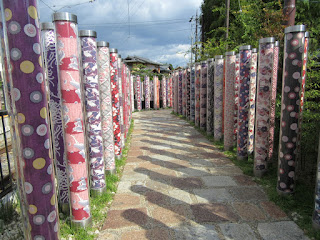We regularly saw kimono being worn by shoppers, passengers on trains, diners in restaurants etc. as well as by shopkeepers and young girls out sightseeing. Almost entirely by women though. I saw very few men wearing the male equivalent, just a few boyfriend/partners squiring their lovely kimono-clad girls around sights. It seems to be a thing in Japan for Japanese women (and some tourists) to wear or hire kimono for a special day out such as seeing some of the heritage sights in Kyoto. I saw many places offering 'the kimono experience' by the hour or for a day, some throwing in professional photo shoots and even videos.
I asked our female tour guide when Japanese women would wear kimono. Basically the answer seems to be for any occasion where we in the West might dress up as well: dining out, special occasions, parties, visiting family, festivals, dates etc.
It's not considered polite in Japan to take pictures of strangers unless it is a general shot of a scene, so I had to be discreet about taking photos.
I saw some gorgeous antique kimono in museums.
Kimono are very expensive. There are shops specialising in selling on secondhand kimono and also yukata (cotton summer kimono). I saw many of these shops on our travels. So colourful.
Kimono-clad dolls are popular, both with tourists as a souvenir and for normal Japanese as gifts to young girls on Girls Day for display in the home.
An Empress and Emperor set of dolls in Kyoto. The Empress wears the 12 layered kimono of the highest nobility
An exquisite doll from a high end shop called Kyugetsu in Asakusa in Tokyo.
Naturally, as a self-respecting tourist, I wanted the opportunity to wear kimono. I did this at a historic Kyoto home being run as a museum, called Tondaya, located in the former textile area of Nishijin. This was 'kimono-light' as it went on over my street clothes, but still involved a surprising amount of layers. There was an undercollar, the kimono itself, an under-tie, a firm 'stomacher' to flatten the midriff, the obi, and the final tie over the obi. The end result felt a bit like wearing a corset over a dressing gown. I felt very cinched in around my middle, the obi layers creating a stiff barrier from around my bustline down to the top of my hips. No wonder all the kimono ladies I saw were sitting so upright! Sadly I look more middleaged and portly than the slim elegant Japanese ladies... DH also wore a kimono and looked quite good.
We spent a morning in the Arashiyama area of Kyoto, where I loved an art installation called Kimono Forest at the tram station. It was a short walkway lined with clear pillars protecting all different kimono fabrics, so colourful and pretty. Lots of Japanese and foreign tourists were posing for their photos on the walkway.
A couple of the hotels we stayed in provided yukata for lounging around in. I also bought a couple for myself - they're a bit wrinkled in the photos from coming home in my suitcase.
This is a tourist yukata with a self-belt, which I
bought at the Oriental Bazaar shop in Tokyo. It's short enough
to wear like a dressing gown.
This is a real Japanese yukata, which I bought in
a secondhand kimono shop. It's much longer as it's designed
to be worn with all the underbelts and an obi, and the
excess length would be bloused out over the belt and hidden under
an obi. I may shorten it to wear as a robe, or I may
cut it up to use the cotton fabric in a project.
This is one the extra daily blog posts I am making this week about my holiday in Japan, there will be another one tomorrow. Hope you liked this one!



























No comments:
Post a Comment